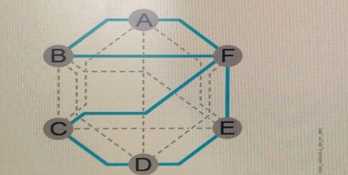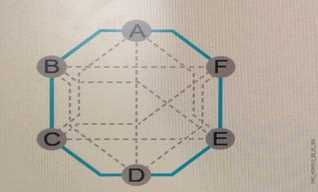nokia 4a0-255 practice test
Nokia Advanced Optical Network Design
Question 1
Refer to the exhibit that shows a demand matrix, a network topology with candidate links (in thick
blue lines and dashed lines), the defined network in thick blue lines and the demand routing (colored
numbers in the figure). Every link is 80 km long. Which of the following requirements is supported by
this network design with the displayed demand routing?
- A. 1+1 protection
- B. Minimum cost design
- C. Minimum latency
- D. Resilience against two link faults
Answer:
A
Question 2
Consider the exhibit showing the schematic for an NE in a deployed optical network. The traffic
growth forecast is for the use of 40 channels in 3 years. The customer needs to reduce the space for
the shelf. Among the following, which additional input is NOT necessary to meet these specific
requirements?
- A. Rack size
- B. Expected traffic added-dropped at the site
- C. Mean time to repair for the equipment
- D. Power supply
Answer:
D
Question 3
Consider the exhibit that shows a network with a full mesh fiber structure. Link weights indicate the
cost. Future services can be requested between any node pair.
Which of the following topology represents a minimum cost design (minimum overall fiber cost)
where link failure survivability is ensured?
A)
B)
C)
D)
- A. Option A
- B. Option B
- C. Option C
- D. Option D
Answer:
B
Question 4
Suppose there is a 40 Gbit/s signal which has a symbol rate of Gbaud/s. Which modulation format is
being used?
- A. QPSK
- B. BPSK
- C. 4QAM
- D. DP-QPSK
Answer:
C
Question 5
What is guardband required for?
- A. To reduce the impact of chromatic dispersion.
- B. To properly use the available bandwidth of the fibers.
- C. To enable each channel to support a higher modulation format.
- D. To reduce non-linear impairments between coherent and non-coherent channels.
Answer:
D
Question 6
Which of the following is NOT an advantage of super-channels?
- A. Improved spectral efficiency
- B. Simplified management of the carriers
- C. Narrower spacing between carries of the super-channel
- D. Impairment-free transmission
Answer:
C
Question 7
Which of the following is NOT a functionality provided by a coherent receiver?
- A. Analog-to-digital conversion (ADC)
- B. Digital signal processing (DSP)
- C. Mixing
- D. Demultiplexing
Answer:
C
Question 8
Consider a signal at 100G PDM-QSK. Which of the following statements is true?
- A. It supports more bits per symbol per polarization than 8QAM
- B. It has the same Gbaud rate as 100G 8QAM.
- C. Each symbol supported 2 bits per polarization.
- D. The Gbaud rate is 50.
Answer:
A
Question 9
Where is guardband mandatory for EMF?
- A. Between 10G and 40G channels
- B. Between 10G and 100G channels
- C. Between 10G and 200G channels
- D. Between 40G and 100G channels
Answer:
C
Question 10
Which of the following best describes Flexgrid?
- A. Flexgrid is based on flexible amplification stages
- B. Flexgrid uses flexible guardband that can take any spacing.
- C. Flexgrid is defined on a frequency grid spacing based on ,multiples of 12.5 GHz.
- D. Flexgrid allows channel bandwidth central frequencies and guardband to take any value in the spectrum range.
Answer:
A
Question 11
Which of the following best describes self-phase modulation?
- A. It is a type of modulation format exploiting the phase to carry information.
- B. It is a phase shift suffered by an optical signal caused by its power intensity.
- C. It is s type of impairment that can be compensated using DCMs
- D. It is a type of impairment cause by spectrally adjacent channels.
Answer:
D
Question 12
Consider the exhibit that shows a link power budget diagram. Which of the following is represented
at location 2?
- A. Power range
- B. OSNR margin
- C. Minimum attenuation
- D. System aging margin
Answer:
A
Question 13
Which of the following statements about the Decision (HDEFC) decoding and soft decision FEC
(SDFEC) decoding is FALSE?
- A. HDFEC injects less latency into the decoding process than SDFEC.
- B. HDFEC provides a higher coding gain than SDEFC
- C. HDFEC uses fewer thresholds than SDEFC.
- D. HDFEC discards bits earlier in the decoding process than SDEFC.
Answer:
A
Question 14
Which of the following statements about Bit Error Rate (BER) is correct?
- A. BER is the ratio of redundant bits to correct bits.
- B. BER is measured at both the transmitted and receiving ends.
- C. BER can be measured before after the FEC decoding.
- D. BER can be accurately measured in a short period of time , for any rate.
Answer:
B
Question 15
Consider two EDFA amplifiers in cascade. Each EDFA has an average input signal power of 10 mW and
an average noise power of 1 mW. What is the OSNR of the system at the receiver.
- A. 20 dB
- B. 10 dB
- C. 7 dB
- D. 5 bB
Answer:
A